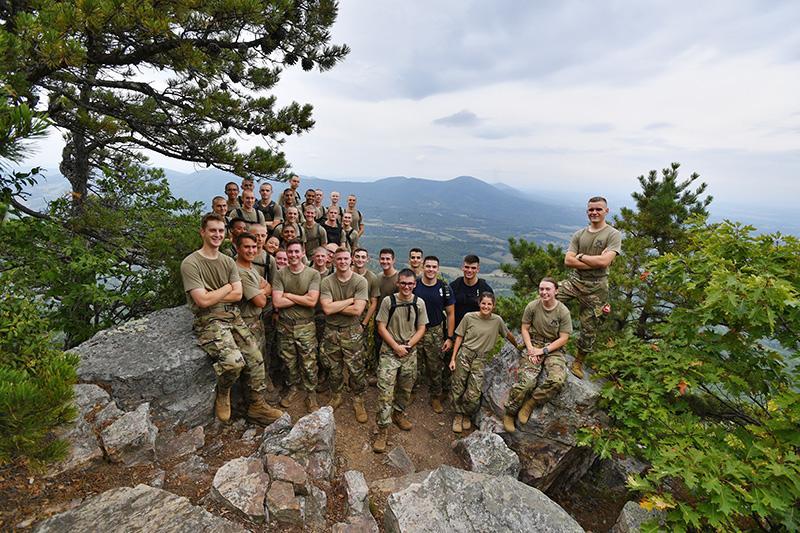Rat Challenge Returns to House Mountain

Company G rats, House Mountain station cadre, and Capt. Katie Baur stop for a photo on top of Little House Mountain’s northern summit Sept. 5.—VMI Photo by Kelly Nye.
By Kelly Nye
LEXINGTON, Va., Oct. 11, 2019—After a one-year location switch to Brushy Hills Preserve, the physical education department has returned to House Mountain for one of the most physically demanding stations of the Rat Challenge training program.
It was a welcome move, considering VMI and the mountain’s long history together.
One of the very first experiences of the Rat Line is a hike to the top of Big House Mountain. But Rat Challenge offers rats a much faster, more exclusive trail to the summit of Little House.
Despite the name, Little House Mountain is the more arduous of the two hiking experiences. And according to Col. Jay Johnson, professor of physical education and director of Rat Challenge, it may even be the most physically demanding event of the program.
“It’s a straight up hike, very physical,” said Johnson. “It is absolutely the most physical challenge of Phase One [of Rat Challenge].”
House Mountain consists of two peaks with a sloping area between known as the saddle. At their highest points, the two mountain tops are only a couple hundred feet apart in elevation. Little House is the iconic view from Lexington and can be seen from the Parade Ground. The ridgeline behind it is Big House. During Matriculation Week rats are led to the southern summit of Big House by commandant staff and cadre via the public trail.
Rat Challenge, which takes place over 10 weeks in the fall semester with multiple stations on and off post, uses a different trail, most of it through private property, to access the northern summit of Little House.
The comparison between the hikes up Little House and Big House are stark. The Little House trail is short but steep, gaining about 1,300 feet over the course of 1.07 miles. The group starts on private property, unlocking a gate to reach the trail head on the eastern slope of the mountain. The private trail eventually meets the public trail near the top. The Big House trail is more than twice as long. Hikers start in the parking area on the southern end of the mountain then wind through the saddle first, gaining about 1,500 feet overall.
“It is a vertical mile,” is how Capt. Katie Baur describes the trek up Little House, adding that it takes the rats 30 to 40 minutes to reach the top. Baur is a PE instructor and one of the faculty members leading the station. Along with PE instructor Capt. Jim Whitten, she climbs the mountain with the cadets twice a week for the first five weeks of the semester.
“It never gets any easier,” added Whitten.
For the public to access the same summit on Little House, the trail is less steep but much further than the route the rats take. It is approximately four miles from the parking lot with an elevation gain of about 1,260 feet at the highest point. After climbing to the southern end of Little House, hikers must walk the ridgeline for roughly a mile before reaching the northern summit.
Thanks to a verbal agreement with the landowners that dates back to the late 1960s—during Clark King’s tenure in the PE department and the inception of Rat Challenge—VMI has access to the faster trail on the eastern side of Little House. Cadets, VMI faculty, and the landowners are the only ones who have climbed it over the last 50 years.
Last year was the only year the trail didn’t see cadets, when the PE department moved the station to Brushy Hills Preserve. The 560-acre watershed tract is owned by the city of Lexington and includes a 14-mile public trail system. But the wooded area offers no clear views, especially in late summer.
“House Mountain is much more of a challenge than Brushy Hills because of how steep it is,” said Ethan Severns ’21, assistant cadet in charge of the station. Severns along with Katie McCommons ’21 were also station cadre on last year’s Brushy Hills hike.
“I am glad that we are able to do House Mountain over Brushy Hills because I feel a greater sense of accomplishment,” McCommons said.
“This has a little more oomph than Brushy,” agreed Baur, pointing out the three spots on the trail where it is so steep cadets use a rope to pull themselves up, adding a technical element to the climb.
Unlike Brushy Hills, the cadets provide a service just by using the private trail. Constant use keeps a trail maintained. And Johnson hopes to get cadets involved in a service project during spring FTX to maintain the trail even more for the landowners.
“Even if they just come for a day to clear trees and limbs, it would help the landowners,” said Johnson.
Maintaining the mountain keeps cadets in shape and strengthens VMI’s relationship with the community, ensuring that future generations of cadets see the view from the top of the mountain they look at every day.
-VMI-
.svg)
.png)